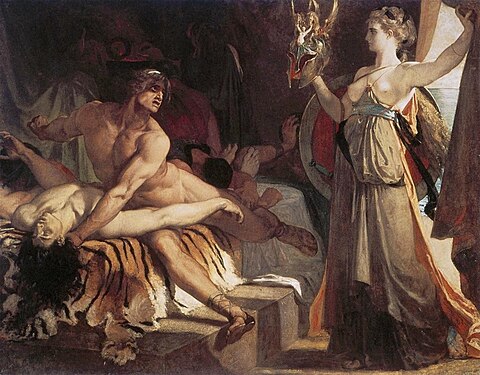Henri Regnault
Henri Regnault | |
|---|---|
 | |
| Born | Alexandre Georges Henri Regnault 31 October 1843 Paris,France |
| Died | 19 January 1871(aged 27) Rueil-Malmaison,France |
| Education | |
| Notable work | Salomé(1870) |
| Style | French Orientalism |
| Parent |
|
| Awards | Prix de Rome(1866) |
| Military career | |
| Allegiance | |
| Branch | French Army |
| Service years | 1870–1871 |
| Battles/wars | |
Alexandre Georges Henri Regnault(31 October 1843 – 19 January 1871) was a French painter.
Biography[edit]
Regnault was born inParis,the son ofHenri Victor Regnault.On leaving school he successively entered the studios of Antoine Montfort,Louis LamotheandAlexandre Cabanel,was beaten for thePrix de Rome(1863) byJoseph Layraudand Xaiver Monchablon, and in 1864 exhibited two unremarkable portraits at theParis Salon.In 1866, however, he carried off thePrix de Romewith a work of unusual force and distinctionThetisbringing the Arms forged byVulcantoAchilles(École de Beaux-Arts).[1]
The past in Italy did not touch him, but his illustrations to Wey'sRome[2]show how observant he was of actual life and manners; even hisAutomedon(School of Fine Arts), executed in obedience to Academical regulations, was but a lively recollection of a carnival horse-race. AtRome,moreover, Regnault came into contact with the modern Hispano-Italian school, a school highly materialistic and inclined to regard even the human subject only as one amongst many sources of visual amusement. The vital, if narrow, energy of this school told on Regnault with ever-increasing force during the few remaining years of his life.[1]
In 1868 he had sent to theSalona life-size portrait of a lady in which he had made one of the first attempts to render the actual character of fashionable modern life. While making a tour inSpain,he saw GeneralJuan Primpass at the head of his troops, and received that lively image of a militarydemagoguewhich he afterwards put on canvas, somewhat to the displeasure of his subject. But this work made an appeal to the imagination of the public, while all the later productions of Regnault were addressed exclusively to the eye.[1]
After a further trip toNorth Africa,abridged by the necessities of his position as a pensioner of the school of Rome, he paintedJudith,then, in 1870,Salomé,and, as a work due from the Roman school, dispatched fromTangierthe large canvas,Execution Without Hearing Under the Moorish Kings.TheFranco-Prussian Wararose, and found Regnault at theBattle of Buzenval,where he was killed on 19 January 1871.[1][3]
His friend, the composerCamille Saint-Saënsdedicated hisMarche héroïque(1871) to Regnault's memory. The sculptorHenri Chapuerected a monument to him in the courtyard of theÉcole des Beaux-Artsin 1872.Jean-Louis-Ernest Meissonierpainted him in the centre of hisLe siège de Parisas the soldier collapsed against the personification of Paris.[citation needed]
Gallery[edit]
-
Automedon with the Horses of Achilles(1868),Museum of Fine Arts, Boston
See also[edit]
References[edit]
Footnotes[edit]
Bibliography[edit]
- This article incorporates text from a publication now in thepublic domain:Chisholm, Hugh,ed. (1911). "Regnault, Henri".Encyclopædia Britannica.Vol. 23 (11th ed.). Cambridge University Press. p. 46.
- Gotlieb, M. (2016).The Deaths of Henri Regnault.University of Chicago Press.




